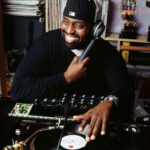Pole dancing, a captivating art form celebrated worldwide for its athleticism and sensuality, often sparks debate about its true beginnings. While some seek to distance it from its adult entertainment roots, the reality is that modern pole dance owes a significant debt to strippers and the vibrant world of striptease. This exploration delves into the fascinating history of pole dancing, tracing its journey from ancient practices to its modern form, and proudly acknowledging the pivotal role of Strippers Dancing in shaping this dynamic art.
Unveiling the Ancestry of Modern Pole Dance
Discussions about pole dancing’s historical roots frequently touch upon ancient movement forms. Mentions of tribal dances from Africa, the festive Maypole dance, the strength-focused Mallakhamb, and the acrobatic Chinese pole often surface. Mallakhamb and Chinese pole, in particular, are sometimes highlighted by those wishing to separate contemporary pole dance from its stripper origins. However, while these historical practices offer interesting parallels, they are not the direct lineage of modern pole dance as we know it today. It’s crucial to acknowledge these historical nods while understanding they represent a different branch in the evolution of movement around a pole.
Ancient Poles: Tracing Early Uses
While anecdotal evidence suggests poles were incorporated into various tribal and Sumerian dances, concrete documentation of pole usage for dance and acrobatics emerges around the 12th century AD, spanning Europe, India, and China.
PolePedia highlights the Maypole dance, a pagan festival celebrating fertility and the arrival of spring or midsummer. Across Germany, England, and Sweden, women danced in circles around a tall pole, weaving ribbons attached to its top, a ritual often accompanied by feasting and, in pre-Victorian times, orgies.
Originating in India around the same period, Mallakhamb, meaning “wrestling pole,” is a display of gymnastic prowess and endurance around a wooden pole. Primarily practiced by men seeking to build strength for wrestling, Mallakhamb, despite its lack of glitter and heels, is sometimes invoked to draw a distinction from strippers dancing.
 Mallakhamb performers demonstrating strength and flexibility on a wooden pole
Mallakhamb performers demonstrating strength and flexibility on a wooden pole
Chinese pole, or “acrobatic pole” as it’s known in China, also dates back to the 12th century. This discipline, again predominantly male, involves acrobatic feats on two rubber-coated poles, demanding strength and agility to leap and pose. The rubber coating provided grip, but athletes required layers of clothing to prevent friction burns.
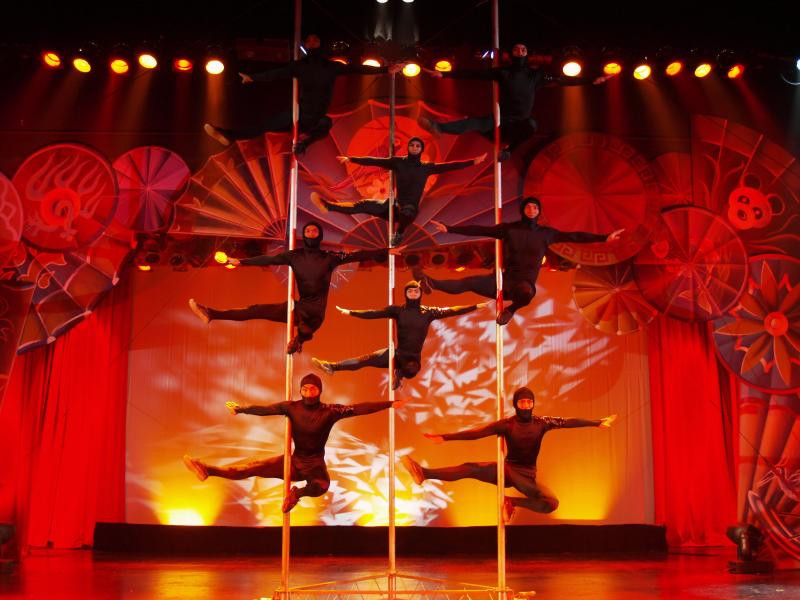 Chinese pole performers executing acrobatic moves on rubber-coated poles
Chinese pole performers executing acrobatic moves on rubber-coated poles
According to Instagram user @divnnvx, drawing a direct line from Chinese pole to modern pole dance is illogical. Firstly, terminology differs: “sexy pole” is termed “steel/metal pole dance” or “dancing with steel/metal pole,” distinctly different from “acrobatic pole.” Secondly, modern sexy pole is a female-dominated industry with a focus on feminine styles, a world apart from the largely male acrobatic focus of Chinese pole.
While these historical practices are noteworthy, modern pole dance’s lineage is far more intertwined with the world of showgirls and performance art. The true history of pole dancing is inseparable from the evolution of striptease, Burlesque, Vaudeville, and sex work, where strippers dancing pioneered the moves and the stage.
The Seductive Sway of the Hoochie Coochie and “Exotic Dance” in America
The narrative of modern pole dance truly begins in the late 19th century United States with the emergence of the “Hoochie Coochie” dance. This term encompassed provocative and sensual dances, including belly dancing, which captivated audiences.
https://www.instagram.com/p/CJ9MIfxgl7P/?utm_source=ig_embed&utm_campaign=loading
The “Little Egypt” traveling circuses of the 1800s were a popular form of American entertainment. They featured Middle Eastern and Romani dancers performing within circus tents. These Hoochie Coochie dancers innovatively utilized the central tent pole to enhance their performances. They climbed, struck poses, and spun around it, adding a new dimension to their alluring routines and thrilling onlookers. These performers defied societal norms, adorning themselves with jewels, short skirts, and midriff tops, a stark contrast to the corsets and petticoats of the era. Their daring performances and suggestive movements laid early groundwork for what we recognize today in strippers dancing.
Kitty Velour notes that the popularity of these dances led to their “import” into Europe, often featuring white dancers instead of Middle Eastern performers. This period coincided with the increased use of the term “exotic dancer.” For many in the pole and stripping communities, this term carries racist connotations. As Hoochie Coochie dances spread to Europe, Black or Middle Eastern dancers were labeled “exotic,” creating an “othering” effect and distancing them from their white counterparts. More recently, pole dancer Nadia Sharif and stripper activist Nova Caine have raised awareness about the racist origins of “exotic dancer,” urging the pole industry to find more respectful terminology for dancing in heels.
https://www.instagram.com/p/CLmHEf6AzQc/?utm_source=ig_embed&utm_campaign=loading
https://www.instagram.com/tv/CLkPRk0FHNu/?utm_source=ig_embed&utm_campaign=loading
Vaudeville and Burlesque: The Stages are Set
In Chrome Chronicles’ exploration of sexy pole pioneers, pole star Jordan Kensley refers to Vaudeville as the “grandmother” of pole. In the early 1900s, Vaudeville shows in the United States incorporated comedy and dance with elements of striptease, creating a risqué entertainment landscape.
However, Prohibition, with its ban on alcohol and societal push for “appropriate” entertainment, caused a “moral separation” within Vaudeville. Jordan explains, “Acts that were deemed publicly appropriate went to the circus (contortion, silks, trapeze etc.),” while the more sensual aspects of Vaudeville – Burlesque and striptease – were forced underground into speakeasies. Limited space in speakeasies led performers to bar counters or small stages. Bar patrons, seeking safety for the performers, installed poles, enabling them to hold onto something while stripping. This improvisation, born out of necessity in illicit bars, marks a crucial step in the evolution of strippers dancing around a pole.
According to Alice Wanderlust, this era saw the birth of America’s first dancer bar. She recounts the New Orleans Club in 1933 San Francisco, a city that defied Prohibition, which “was said to have an old pipe that was on the front part of their makeshift stage.” However, the speakeasy’s closure means its history relies on oral accounts, lacking concrete online verification beyond dancer anecdotes.
With the end of Prohibition, Burlesque shows re-emerged into the open. However, the popularity of pole-assisted table dances during Prohibition solidified the pole’s place in sexy performances. Bar and restaurant owners adapted their venues to accommodate these dances, with and without poles. From this point, Jordan notes a divergence into three performance styles: Burlesque, circus arts, and pole dance, all sharing roots in the sensual performance world, and heavily influenced by the techniques of strippers dancing.
https://www.instagram.com/p/B4Hn0zDFVwV/?utm_source=ig_embed&utm_campaign=loading
Alice Wanderlust identifies Mary’s Club in Portland, Oregon, opened in 1954, as the first official pole dancing bar. Mary’s Club stage featured a brass pole at the corner where the stage met the stairwell, overlooking the basement stairs. Alice argues that this is the genesis of pole dancing as we know it. Mary’s initially hosted variety shows, embracing diverse dancers before focusing primarily on striptease, solidifying the link between pole work and strippers dancing.
Topless dancing emerged in the following decade, debuting in 1964 at Condors Gentleman’s Club in San Francisco’s North Beach. Alice Wanderlust writes:
“The club’s decision to feature topless dancers marked a significant departure from traditional burlesque shows, paving the way for the modern strip club industry. One of the most famous performers to grace the stage at the Condor Club was Carol Doda, who became an icon of the 1960s counterculture movement. Doda’s revolutionary act, which involved her dancing topless while suspended from a piano wire above the bar, drew national attention and helped catapult the Condor Club to fame as well as launching more women to do daring movements we see on the pole today.”
Stripping through History: Disrobing the Origins of Modern Day Pole Dancing – Alice Wanderlust
Lap dancing, frequently associated with stripping and pole dance, became a staple of strip clubs in the 1980s. Shortly after, in 1993, Pleaser Shoes, the iconic stripper shoe manufacturer, began operations. Around this time, pole dancing began its migration out of strip clubs and into a wider sphere, though its foundational techniques remained deeply connected to strippers dancing.
Canadian Strip Clubs: The First Pole Teaching Grounds of the 1980s
Various sources point to the 1980s as a period of significant growth in stripping’s popularity, establishing it as a fixture in North American culture. The imagery of money showering strippers originates from US and Canadian strip clubs, where paper currency made this literal “making it rain” possible.
https://www.instagram.com/tv/CDexhI3FM6c/?utm_source=ig_embed&utm_campaign=loading
In a “Yes A Stripper” podcast episode, Crimson Misty and AM Davies trace stripping’s (and thus, modern pole dance’s) origins in Canada, specifically Vancouver. Vancouver’s lenient liquor licenses and laws in the 1980s fostered a thriving strip club scene. Strippers were treated as professionals, even having agents to arrange club bookings.
This environment led club owners to recognize the value of skilled dancers. Top strippers were hired to train others within clubs during the 1980s and 1990s, passing down the techniques of strippers dancing. Recognizing the appeal of pole tricks to women outside the strip club world, many of these strippers ventured out, teaching privately or opening their own pole studios, marking the formalization of pole dance instruction beyond the adult entertainment industry.
The Emergence of Pole Dance Studios and Competitions
Contrary to popular belief, Fawnia Mondey was not the first stripper to open a pole dance studio. However, she was among the first prominent strippers to teach in Canadian strip clubs, starting in 1994. Crimson Misty and AM Davies note that Fawnia stripped for a short period before teaching from a shoe shop in Vancouver in 1998. She later moved to Nassau and paused teaching. PolePedia credits her as the first to release at-home pole dance tutorials in 2001.
Crimson Misty and AM Davies credit Pole Junkies in Edmonton, founded by Alena Downs, as the first official pole studio, opening in her basement in 2004. Alena, a top Canadian entertainer, had been teaching bar classes since 2002 and had won several pole dance titles. Pole Junkies expanded to multiple locations and became a major online pole community.
S Factor, the studio featured in Strip Down, Rise Up, now facing allegations of racism and coercion, was founded shortly after by actress Sheila Kelley in Los Angeles. However, Crimson and AM note that S Factor initially distanced itself from “pole,” marketing itself as “feminine movement” rather than explicitly pole dance or pole fitness, perhaps in an attempt to further separate from the image of strippers dancing, even while benefiting from techniques they pioneered.
In the same year, Tracy Gray and Christine Boyer established Aradia Fitness, opening their first Vancouver studio, which grew into a large North American franchise. Also in 2004, Tammy Morris launched Tantra Fitness in Vancouver, another successful franchise. In 2005, Fawnia Mondey opened her studio, Pole Fitness Studio, in Las Vegas.
Black strippers during this period, although often uncredited, were instrumental in shaping modern pole dance. They pioneered moves and styles now considered fundamental. In 2008 Atlanta, at the Magic City Club, the “making it rain” era began, with strip club success driving innovation in moves, incorporating styles like twerk and bounce into pole routines, directly influenced by strippers dancing in these clubs. AM and Crimson also highlight Los Angeles-based dancers Natalie Clark, Angel Dust, Josiah Grant as pioneers, some of the first strippers to travel globally and be paid to teach. X Position, a Black-owned and Black-run studio, opened in LA during this period, with AM as its first white instructor.
2005 also marked the first World Pole Championships in Amsterdam, with strippers as prominent competitors, further cementing the link between competitive pole and the artistry of strippers dancing.
Pole and Striptease History in the United Kingdom
Kitty Velour, in Chrome Chronicles Pole’s blog, traces the first UK strip club to the 1950s: Paul Raymond’s members-only Soho club, Raymond Revue, now The Box.
The 1960s UK law permitted full nude dances, and Soho became London’s red-light district, with peep shows, strip clubs, and a sexually liberated atmosphere.
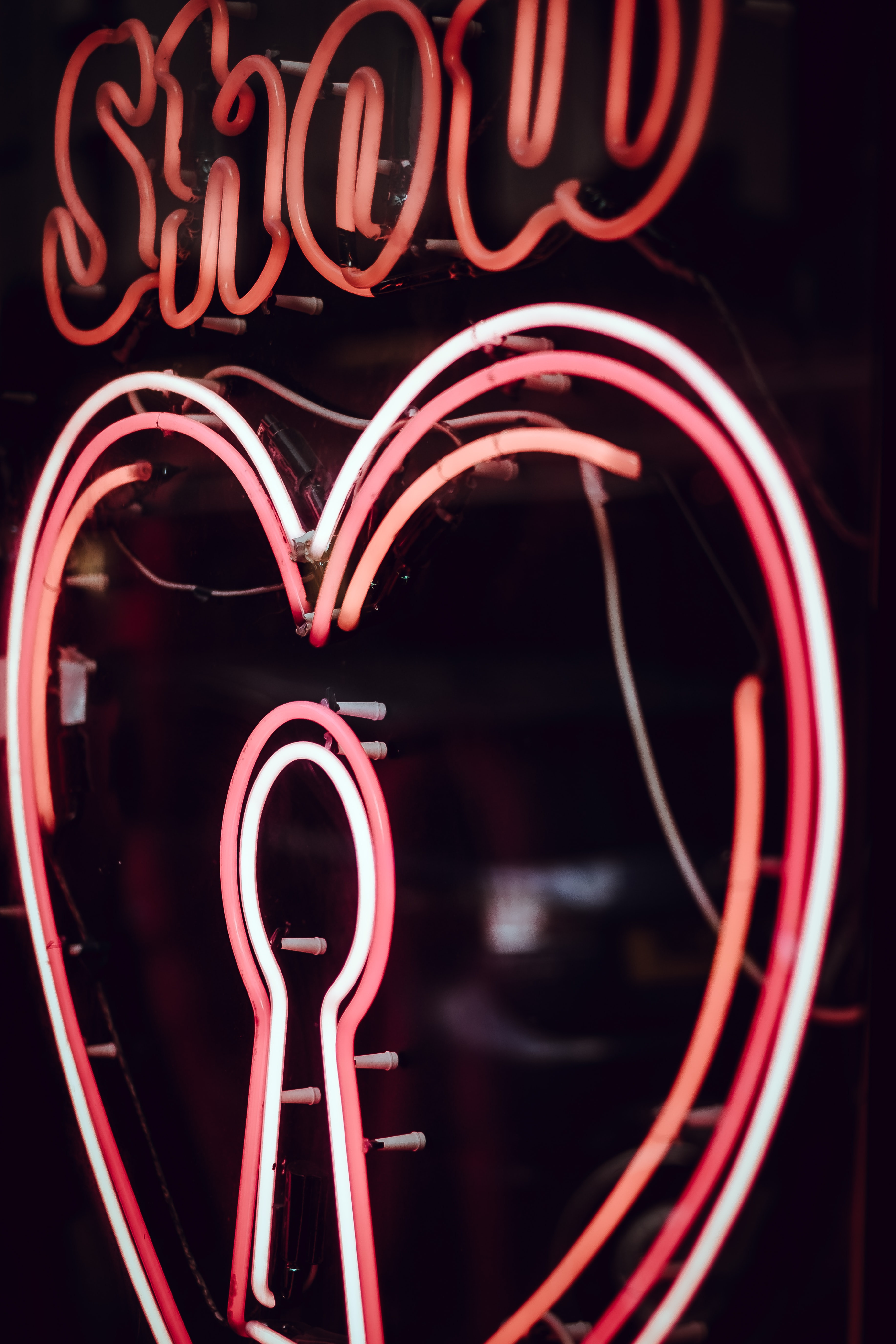 A dimly lit street scene in Soho, London, hinting at its nightlife and entertainment history
A dimly lit street scene in Soho, London, hinting at its nightlife and entertainment history
The 70s and 80s saw the rise of strip pubs in London’s East End, featuring stage shows where showgirls would circulate among patrons with empty pint glasses for tips – a tradition that, according to Kitty and @mistypoledancer’s “Glitter&Garterz” video series, continues today. Shows were theatrical, incorporating props, costumes, and even wedding dresses, showcasing the performance aspect of strippers dancing.
https://www.instagram.com/p/CQJsM–ASEY/?utm_source=ig_embed&utm_campaign=loading
The 1990s saw Europe’s first Burlesque school open in London, credited by Kitty Velour to Madame Jojo, owner of Soho’s famous cabaret and Burlesque club, now closed due to gentrification.
Lap dances and private dances gained popularity later, but stage shows remained central. The White Horse was a renowned East End strip pub, hosting Kitty, Felicity Logan, and Millie Robson. The East London Strippers Collective (ELSC), a stripping trade union, originated here. Kitty notes:
“Although we romanticise the strip pubs, they did have their issues with the management sacking girls for trivial reasons. Most of the girls in ELSC have worked and been sacked from the White Horse (including myself).”
Kitty Velour
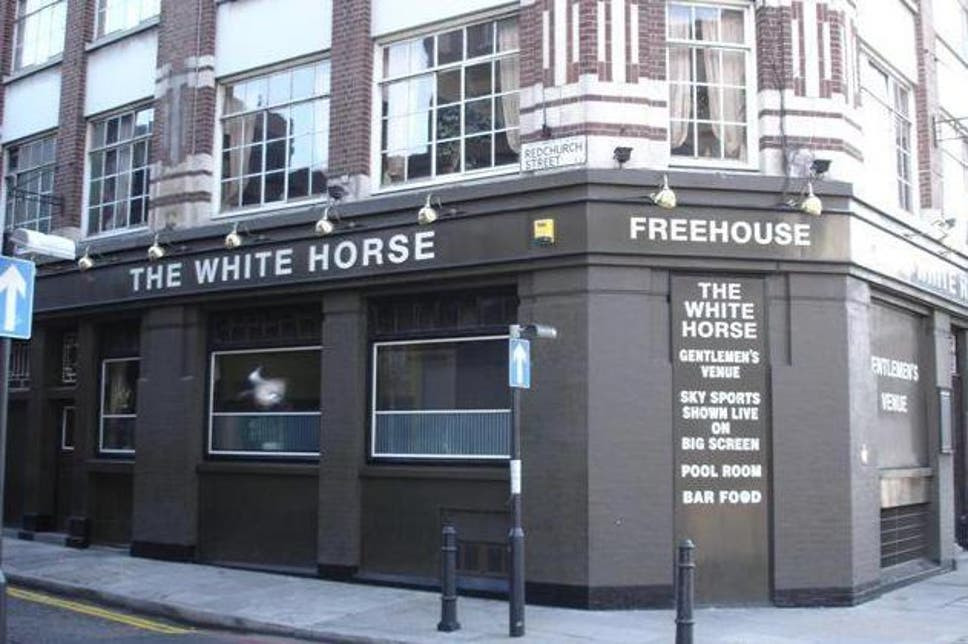 Exterior of The White Horse pub, suggesting its traditional pub facade and history as a strip pub
Exterior of The White Horse pub, suggesting its traditional pub facade and history as a strip pub
Like in the US, London’s first pole dance studios emerged in the early 2000s. PolePeople, near Moorgate and Liverpool Street, opened in 2003, preceding its Canadian counterparts. In 2005, the London Academy of Poledancing in Clerkenwell (now London Dance Academy) followed. Both studios are still operational, joined by numerous others, marking the mainstreaming of pole dance beyond the direct influence of strippers dancing, though still carrying that heritage.
Pole Dancing in Australia: Mainstreaming the Sensual Art
Starting pole dance in Sydney in 2016, the mainstream acceptance of pole in Australia, compared to Italy, the US, and the UK, was striking. Pole in Australia followed a similar trajectory to Canada and the US but became more publicly visible and less subcultural.
In early 2000s Sydney, Bobbi Vivoda, a stripper and pioneer who sadly passed away in 2020, began teaching pole dance to colleagues at Dancers Cabaret in King’s Cross in 2002. Classes were held in the club bouncers’ training room.
According to Australian Pole Dancers Magazine, Bobbi’s desire to open public classes led the club owner to agree, taking a percentage of her earnings. A Sydney Morning Herald article about her classes drew 100 women eager to learn pole dance. Strippers Candice Leigh and Jamilla Deville joined, sparking Australia’s booming pole market.
Despite popular belief, Jamilla did not invent the Jade Split. AM Davies and Crimson Misty credit Pantera Blacksmith with creating the move. Bobbi and Jamilla learned it from Pantera’s video, naming it “Ja – De” after Jamilla Deville.
https://www.instagram.com/p/CLxCwRZBZRO/?utm_source=ig_embed&utm_campaign=loading
In 2004, Bobbi opened her first Sydney studio, also releasing instructional DVDs. Pole studios proliferated, and in 2005, Bobbi created Miss Pole Dance Australia, a glamorous competition. Hosted by drag queen Maxi Shields, Jamilla Deville won the first edition.
Australia is vital in pole history, fostering the showgirl aesthetic, spinning pole flows, and influential figures like Felix Cane, Michelle Shimmy, and Maddie Sparkles. Competitions like Dance Filthy, Pole Theatre, and Floorplay also originated in Australia. The acceptance of pole in Australia meant less stigma, with pole shows in mainstream pubs and studio showcases hosting up to 500 attendees, celebrating the athleticism and artistry derived from strippers dancing.
Russian Pole Dance: Gymnastics Meets Sensuality
Russia has become a powerhouse in pole dance, known for breathtaking Russian heels flow and gymnastic-inspired tricks.
Miss Diana Exotic Pole interviewed Svetlana Orlova, a Russian pole pioneer who opened St. Petersburg’s first pole studios and organized championships.
Svetlana began teaching pole in 2005 at “Vizit” dance studio. Inspired by a Felix Cane video, the studio owner asked if she could teach pole. Svetlana agreed but realized her choreography background wasn’t enough – she hired a stripper to train her. Miss Diana writes:
“Her first teacher was a stripper, of course, and everybody who opened first pole studios in St. Petersburg was coming from the stripping industry one way or another: either working as choreographers or as dancers at clubs.”
Miss Diana Exotic Pole
Svetlana notes early Russian pole wasn’t “pole fitness.” They initially performed barefoot to differentiate from striptease, but learned from strippers nonetheless. Pole’s popularity grew, and Svetlana opened “Erodance” studio in 2007, offering striptease, erotic dance, chair dance, and twerk, alongside pole, acknowledging the diverse influences on strippers dancing and related styles. Olga Koda was also part of her team.
Two more St. Petersburg pole studios opened in 2007: “Magnit” by Julia Irinina and “Blacky” by Ekaterina Romanova. Both Julia and Ekaterina were strippers before opening their studios, according to Svetlana.
In 2008, Svetlana organized Russia’s first pole championship, Miss Pole Dance Russia, won by Vardanush Martyrosyan (Varda) with a stripping-inspired routine. In 2009, Svetlana and Olga Chapman organized Russia’s first pole fitness championship.
In 2012, Svetlana’s Afrodiziak competition separated pole fitness and heels pole, with “Exotic” becoming a heels-focused category.
The industry now questions “Exotic,” but when the term sparked debate, Eastern European polers explained its choice as a “shield” against the stigma of stripping in Russia, not intending to “other.” While the term’s origins are problematic, and it doesn’t encompass heels pole styles, finding a better term is crucial to honor all dancers and move beyond potentially harmful language rooted in the history of strippers dancing and its perception.
Pole Dance in Europe: A Patchwork History
Information on pole history in the rest of Europe and non-English speaking countries is scarce, even in Italian, my native language.
Italy was a latecomer to pole, with classes starting in home studios around 2007. Studios or gyms opened in 2009 in Milan, Rome, and Bologna, focusing on “pole fitness” and tricks, often sanitized in Catholic, conservative Italy.
Italy’s first championship, endorsed by the Federazione Italiana di Pole Dance, was in Rome in 2010, won by Sara Brilli. In 2011, the Federation launched the Italian Pole Championship with strict, gymnastics-inspired rules. The Italian Pole Dance Contest followed in 2013, also trick-based.
Unofficial sources (Italian polers near US military bases) suggest US-style strip clubs and striptease gained popularity in Italy in the 80s, 90s, and 00s, showcasing a sexier pole style influenced by North American culture, though this wasn’t immediately reflected in studios. “Sexy” pole comps began in 2016 with Exotic Moon, by Natalya Ryzhikh of Turin Pole Dance Studio. Exotic Goddess by Letizia Saquella in Rome followed in 2019, acknowledging the growing acceptance of sensuality in pole, and indirectly, the legacy of strippers dancing.
https://www.instagram.com/p/B05TTO0BjFf/?utm_source=ig_embed&utm_campaign=loading
In Germany, former stripper Nele Sehrt began teaching tease dance in 2002 and pole in 2004. Based in Hamburg, Nele trained many current European studio owners.
https://www.instagram.com/p/B6bVDDnoht8/?utm_source=ig_embed&utm_campaign=loading
Heels legend Jazzy K notes Swiss pole emerged around 2009, taught by someone trained by Nele. “They even had their first teacher trainings in the strip club,” Jazzy says, directly linking early pole instruction back to the environment of strippers dancing.
Information on modern pole history in France, Spain, Germany, and other European nations remains limited.
Pole History in Asia: Emerging Scenes
Most pole history accounts prioritize the US, Canada, UK, and Australia, neglecting Asia and Africa. These regions’ histories are less documented and were added later thanks to pole dancer input.
China (Special thanks to @divnnvx)
Historically, stage performance was discouraged for women in Chinese culture. During the Qing dynasty (1644-1911), women were banned from stage performances. Peking opera was male-dominated, with men playing female roles. Mixed troupes returned after the Qing dynasty, but patriarchal norms concerning female expression and sexuality persist.
However, attitudes are shifting. While pole dance may still face disapproval, it’s gaining popularity. CNN reported Luo Lan’s Pole Studio as one of China’s first in 2005. Her chain has 24 schools and students have opened 600 more across China. Jady Chow of Pole Divas was also a Chinese pole pioneer.
Links to nightlife, though not explicitly stripping, appear in an interview with pole world champion Coco Kehong, who said about starting pole: “I didn’t have any foundation about dance. I worked as a waiter in a bar. I saw some pole dance show there which interested me.” This suggests that even in regions where stripping culture differs, the influence of performance environments akin to those where strippers dancing flourished is still present.
https://www.instagram.com/p/CQf6gPmAR2V/?utm_source=ig_embed&utm_campaign=loading
Pole’s growing popularity is leading to TV appearances, interviews, and Chinese athletes competing in world championships, like Fang Yi.
Japan
Joshua Paul Dale traces Japan’s pole boom to a 2004-era craze sparked by Hollywood stars like Madonna, Angelina Jolie, and Kate Moss practicing pole, extensively covered by daytime TV and women’s magazines. “Pole dance became the latest fitness craze, and the sudden demand resulted in an explosion in the number of studios opened by former exotic dancers turned instructors,” Dale writes, directly connecting studio growth to instructors with a background similar to strippers dancing.
Joshua Paul Dale, The Future of Pole Dance
In Tokyo, dancer and teacher Lu Nagata founded Pole Dance Tokyo studio in 2006. Lu’s apprentice Mai Sato, world pole dance champion in 2009 and 2010, instructed at the studio and was Cirque du Soleil’s first Japanese aerialist for “Love.”
https://www.instagram.com/p/CNyPwvylhN2/?utm_source=ig_embed&utm_campaign=loading
South Korea (thanks @dark_moonlite)
Yunjung Kim and Sun-Yong Kwon note Korean for pole dance, “bongchom,” carries connotations of “decadence and vulgarity,” linked to Western pole imagery. Gentlemen’s clubs and strip culture are absent in Korea, altering pole perceptions.
Early Korean pole mentions date to 2006, with online news reporting Australian pole fitness popularity. In 2007, MBC, a major broadcaster, presented pole dance as a Hollywood fitness trend. Despite mainstream appearances, Korean women’s participation wasn’t initially highlighted.
South Korea’s first pole studio, Pole Dance Korea, opened in 2008, hosting annual performances, competitions, and world championships. Polers Korea Dance Studio in Seoul, owned by Poling Mia, is now a major franchise, demonstrating pole’s growth despite cultural nuances around its origins in environments associated with strippers dancing.
https://www.instagram.com/p/B5v6Xm3hHPC/?utm_source=ig_embed&utm_campaign=loading
The Digital Age of Pole Dance
The internet and social media revolutionized pole dance’s popularization. From early stripper videos online to Instagram, pole became increasingly visible.
Instagram’s 2010 launch propelled pole. Polers networked, learned moves, and shared combos and choreographies. Michelle Shimmy is credited with creating the #pd (pole dance) hashtag system, followed by move names – a vital resource for pole inspiration. According to Australian dancers, the #pd system emerged between 2013 and 2016, evolving from the less practical #PoleDanceMove hashtag.
Michelle Shimmy also created #sundaybumday, a popular hashtag celebrating curves and body positivity within the pole community, further shaping the culture around pole, initially developed in spaces where strippers dancing celebrated their bodies.
The 2020-2021 Coronavirus lockdowns shifted pole dance almost entirely online. Studios closed, and online classes, tutorials, workshops, competitions, and instructor training became standard, creating a lasting online pole trend, enabling global learning from pole stars at home.
Simultaneously, social media censorship of sex work and pole dance continues, starting with hashtag shadowbanning – for which Instagram apologized through this blog – to video deletions for copyright claims and account removals. Content erasure threatens pole culture, community, and learning.
However, pole dancers continue to protest, as with #EveryBodyVisible in 2019 and petitions and protests in 2020, fighting for recognition and respect for their art form, born from the stages of strippers dancing and evolving into a global movement.
Sources
[List of sources from original article – keep as is]
Pin this post
[Image Pin from original article – keep as is]
Liked this post? Buy me a pizza 🙂
[Image Buy me a pizza from original article – keep as is]
Share the luv
[Share links from original article – keep as is]
Like this:
Like Loading…

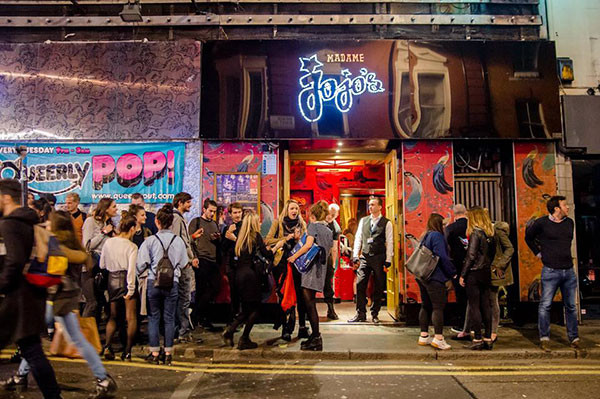 A vintage-style poster or magazine cover advertising a Burlesque club, evoking the era of Soho's nightlife
A vintage-style poster or magazine cover advertising a Burlesque club, evoking the era of Soho's nightlife